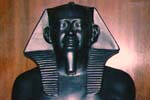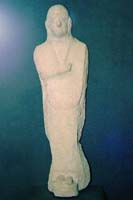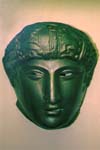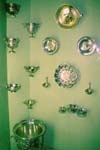
CONTENTS
THE COLLECTION
|
The archaeology collection dates back to 1870, when the original Kelvingrove Museum began collecting objects. The collection includes objects from Egypt, Cyprus, the Italian-Greek colonies and Scotland. EGYPT In 1882 the Egypt Exploration Fund was founded. It carried out annual excavations in Egypt, and was funded by museums, universities and private collectors. The sponsors recieved a share of the finds in proportion to the funding they provided. The Kelvingrove Museum first subscribed to the Fund in 1892, and acquired many Egyptian objects in this way up until the First World War. |
 |
Cast of polished diorite statue of Khephren, 4th King of the 4th Dynasty. The original is in the Cairo Museum. This is one of seven casts of statues in the Cairo Museum donated to the original Kelvingrove Museum by the Museum of Science and Art in Edinburgh in 1877. The seven casts were the first Egyptian objects in the archaeology collection. |
|
ITALIAN-GREEK COLONIES One of the fascinating aspects of the archaeology collection is that many of the objects were donated by amateur collectors. James Stevenson of Hailie, Largs was one such man. He was a partner in a chemical manufacturer which owned a sulphur mine on the island of Vulcano, off the north coast of Sicily. In 1879 he acquired items of pottery from tombs on the nearby island of Lipari, which was colonised by the Greeks in the 6th century BC. The Stevenson collection was loaned to the Kelvingrove Museum in 1885, and was donated to the new Art Gallery and Museum on his death in 1903. |
CYPRUS
|
Cypriot Part of the
|
 |
An amateur collector also made a major contribution to the Museum's collection of objects from Cyprus. Sir Robert Hamilton Lang lived on Cyprus from 1863 to 1872, as British Consul and manager of the Imperial Ottoman Bank's Agency. Lang collected approximately 300 Cypriot objects. The collection consists of about 170 items of mainly Bronze Age pottery, a few bronze weapons, and more than 100 Graeco-Roman glass vessels. The Lang collection was initially loaned to the Kelvingrove Museum in 1870, and was donated to the new Art Gallery and Museum in 1903.
|
|
SCOTLAND Until the 1930s and 1940s, many excavations in Scotland were carried out by amateur archaeologists, whose finds started the Museum's collection. The Museum's first Scottish object, a stone axe, was found very close to the Museum itself, at the corner of Sauchiehall Street and Buchanan Street in Glasgow. Many Scottish objects have also been found by accident, being discovered on hillwalks, dug up in gardens or unearthed during farming activities. The Museum's largest collection of Scottish objects was donated by Ludovic MacLellan Mann (1869-1955), an insurance broker and amateur archaeologist. His collection includes a wide range of objects, from prehistoric to post-Roman and early Medieval times. In 1902 the Andersonian Collection of 130 Scottish items was donated by the governors of the Glasgow and West of Scotland Technical College. |


